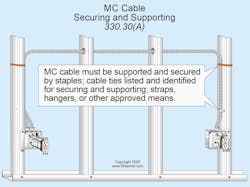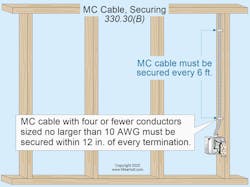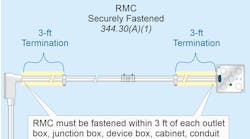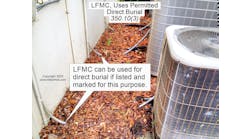Courtesy of www.MikeHolt.com
All questions and answers are based on the 2023 NEC.
Q: What are the requirements for securing and supporting MC cable?
A: The requirements for securing and supporting MC cable are found in Sec. 330.30.
(A) General. Type MC cable must be supported and secured by staples; cable ties listed and identified for securing and supporting; straps, hangers, or similar fittings; or other approved means designed and installed so the cable is not damaged (Fig. 1).
(B) Securing. Type MC cable with four or fewer conductors sized no larger than 10 AWG must be secured within 12 in. of every outlet box, junction box, cabinet, or fitting and at intervals not exceeding 6 ft (Fig. 2).
(C) Supporting. Type MC cable must be supported at intervals not exceeding 6 ft. Cables installed horizontally through wooden or metal framing members are considered secured and supported if such support does not exceed 6-ft intervals.
(D) Unsupported Cables. Type MC cable can be unsupported and unsecured where:
(1) Fished through concealed spaces in a finished building and support is impractical.
(2) Not more than 6 ft long from the last point of cable support to the point of connection to a luminaire or electrical equipment within an accessible ceiling. For the purposes of this section, Type MC cable fittings are permitted as a means of cable support.
(3) Not more than 3 ft from the last point where it is securely fastened to provide flexibility for equipment that requires movement after installation, or to connect equipment where flexibility is necessary to minimize the transmission of vibration from the equipment.
These materials are provided by Mike Holt Enterprises in Leesburg, Fla. To view Code training materials offered by this company, visit www.mikeholt.com/code.







